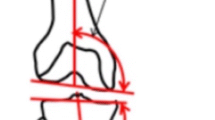Abstract
Introduction
The aim of the present study was to describe the changes in the axis of the knee joint in both radiologically osteoarthritic and non-osteoarthritic knees, on the basis of angles measurable in standardized clinical short knee radiographs, in a cross sectional study of an epidemiological cohort.
Design
From the third inclusion of the Copenhagen City Heart Study, 4,151 subjects were selected for standardized radiography of the knees. After censuring the inclusion, the resulting cohort was comprised of 3,488 individuals. Images were analyzed for radiological knee joint osteoarthritis (OA) and the anatomical femorotibial axis of the knee joint was measured.
Results
The prevalence of knee joint OA in males was 27.9 % and 27.5 %, for the left and right knees respectively. In females this was 32.8 % and 36.4 %. The mean knee joint angles were 4.11° in males; and 5.45° in females. A difference of 1.3° was found between the genders. In non-osteoarthritic knees the increase in valgus orientation in relationship to increasing age was found to be 0.03° and 0.04° per year, respectively, for males and females. Likewise, Kellgren and Lawrence found that OA was seen to influence a shift towards varus of 0.55°–0.76° per level of OA.
Conclusion
Stratification in accordance with morphological severity of OA documented a clear tendency for the axis of the diseased knees to depart from the mean, primarily in the direction of varus. In knees exhibiting no signs of radiographic osteoarthritis we found a significant relationship between increasing age and a shift in the anatomical axis in the direction of valgus.





Similar content being viewed by others
References
Hunter DJ, Niu J, Felson DT, et al. Knee alignment does not predict incident osteoarthritis: the Framingham osteoarthritis study. Arthritis Rheum. 2007;56(4):1212–8.
Brouwer GM, van Tol AW, Bergink AP, et al. Association between valgus and varus alignment and the development and progression of radiographic osteoarthritis of the knee. Arthritis Rheum. 2007;56(4):1204–11.
Khan FA, Koff MF, Noiseux NO, et al. Effect of local alignment on compartmental patterns of knee osteoarthritis. J Bone Joint Surg Am. 2008;90(9):1961–9.
Sharma L, Song J, Felson DT, Cahue S, Shamiyeh E, Dunlop DD. The role of knee alignment in disease progression and functional decline in knee osteoarthritis. JAMA. 2001;286(2):188–95.
Hsu RW, Himeno S, Coventry MB, Chao EY. Normal axial alignment of the lower extremity and load-bearing distribution at the knee. Clin Orthop Relat Res. 1990;255:215–27.
Moreland JR, Bassett LW, Hanker GJ. Radiographic analysis of the axial alignment of the lower extremity. J Bone Joint Surg Am. 1987;69(5):745–9.
Hinman RS, May RL, Crossley KM. Is there an alternative to the full-leg radiograph for determining knee joint alignment in osteoarthritis? Arthritis Rheum. 2006;55(2):306–13.
Kraus VB, Vail TP, Worrell T, McDaniel G. A comparative assessment of alignment angle of the knee by radiographic and physical examination methods. Arthritis Rheum. 2005;52(6):1730–5.
van Raaij TM, Brouwer RW, Reijman M, Bierma-Zeinstra SM, Verhaar JA. Conventional knee films hamper accurate knee alignment determination in patients with varus osteoarthritis of the knee. Knee. 2009;16(2):109–11.
McDaniel G, Mitchell KL, Charles C, et al. A comparison of five approaches to measurement of anatomic knee alignment from radiographs. Osteoarthr Cartil. 2010;18(2):273–7.
Cahuzac JP, Vardon D, de Sales GJ. Development of the clinical tibiofemoral angle in normal adolescents. A study of 427 normal subjects from 10 to 16 years of age. J Bone Joint Surg Br. 1995;77(5):729–32.
Sabharwal S, Zhao C, Edgar M. Lower limb alignment in children: reference values based on a full-length standing radiograph. J Pediatr Orthop. 2008;28(7):740–6.
Schnohr P, Jensen JS, Scharling H, Nordestgaard BG. Coronary heart disease risk factors ranked by importance for the individual and community. A 21 year follow-up of 12 000 men and women from The Copenhagen City Heart Study. Eur Heart J. 2002;23(8):620–6.
Paley D. Principles of deformity correction. Springer; 2002.
Paley D, Herzenberg JE, Tetsworth K, McKie J, Bhave A. Deformity planning for frontal and sagittal plane corrective osteotomies. Orthop Clin North Am. 1994;25(3):425–65.
Kellgren JH, Lawrence JS. Radiological assessment of osteoarthrosis. Ann Rheum Dis. 1957;16(4):494–502.
Laxafoss E, Jacobsen S, Gosvig KK, Sonne-Holm S. Case definitions of knee osteoarthritis in 4,151 unselected subjects: relevance for epidemiological studies: the Copenhagen Osteoarthritis Study. Skelet Radiol. 2010;39(9):859–66.
Wolfe F, Lane NE, Buckland-Wright C. Radiographic methods in knee osteoarthritis: a further comparison of semiflexed (MTP), schuss-tunnel, and weight-bearing anteroposterior views for joint space narrowing and osteophytes. J Rheumatol. 2002;29(12):2597–601.
Vignon E, Piperno M, Le Graverand MP, et al. Measurement of radiographic joint space width in the tibiofemoral compartment of the osteoarthritic knee: comparison of standing anteroposterior and Lyon schuss views. Arthritis Rheum. 2003;48(2):378–84.
Andriacchi TP. Dynamics of knee malalignment. Orthop Clin North Am. 1994;25(3):395–403.
Sharma L, Song J, Felson DT, et al. The role of knee alignment in disease progression and functional decline in knee osteoarthritis. JAMA. 2001;286(2):188–95.
Issa SN, Dunlop D, Chang A, et al. Full-limb and knee radiography assessments of varus-valgus alignment and their relationship to osteoarthritis disease features by magnetic resonance imaging. Arthritis Rheum. 2007;57(3):398–406.
Sharma L, Lou C, Felson DT, et al. Laxity in healthy and osteoarthritic knees. Arthritis Rheum. 1999;42(5):861–70.
Conflict of interest
The authors declare that they have no conflict of interest.
Author information
Authors and Affiliations
Corresponding author
Rights and permissions
About this article
Cite this article
Laxafoss, E., Jacobsen, S., Gosvig, K.K. et al. The alignment of the knee joint in relationship to age and osteoarthritis. Skeletal Radiol 42, 531–540 (2013). https://doi.org/10.1007/s00256-012-1509-z
Received:
Revised:
Accepted:
Published:
Issue Date:
DOI: https://doi.org/10.1007/s00256-012-1509-z




